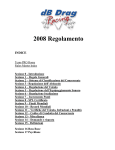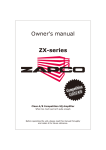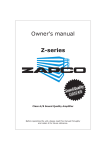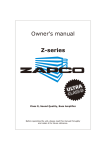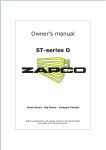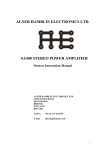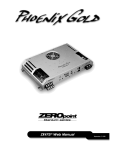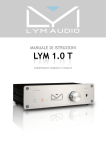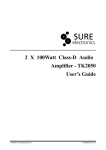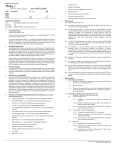Download Zapco C2K-9.0XD Car Audio Amplifier
Transcript
The Zapco C2K-9.0XD and 4KW Why It Is and How It Works The Zapco 9.0XD and the 4KW were both created for the demands of SPL competition. Where they differ from the rest of the SPL amplifiers is that Zapco was determined to build an amplifier that would pound out serious sound pressure but would still produce true Zapco sound quality. The 4KW is a 4-channel amp consisting of two 9.0XD amp boards in a single chassis. Since they are identical in function, I will refer only to the 9.0XD in this article. We knew that to get the power we needed from the 9.0XD, and keep it in a reasonable size, we would have to use a Class D design. We also knew that Class D amplifiers were poor sounding with high distortion levels and that they were only good in bass applications… We needed to change the assumption about Class D, and here it is: Class D amplifiers were inferior because nobody had spent the time or money to build one right. We would and did. The 9.0XD came out in late 2000, and since then it has dominated the street classes at every dB Drag finals. There were eight 1st Place trophies at dB Drag from 2001 to 2004 and seven of them went to Zapco cars. In some classes Zapco cars have taken as many as seven of the top ten places. Moreover, a number of IASCA, sound quality cars have won top honors at the finals using the 9.0XD as a bass amp. There are even show cars using the 9.0XD Class D Zapco amplifiers for mids and highs. How is this possible? The Zapco Class D is a very different Class D. Copper: To move enough current for these power supplies, the 9.0XD uses a massive 4 layer board with 3 Oz copper. One entire layer can be devoted to power and one to the ground plane. The 0-Gauge Positive and Negative connectors are bolted to the board to assure good contact. Capacitance: The 9.0XD uses massive amounts of capacitance. This means that when the big bass note hits, you will always have the voltage to pound it out. Post-Tripath Filtering: Do we all know now that there is no such thing as Class T? Well now we do. The name “Class T” comes from the Tripath control chip that takes Class D amps to the full range realm. It does a commendable job. However, it doesn’t make Class D listenable to Zapco standards. To make the 9.0XD acceptable to our standards of sound quality, Zapco developed a post-processing filtering system consisting of three independent filtering sections in each channel after the Tripath chip. This filtering provides the sound quality of most Class A/B amplifiers with the benefits of the Class D size and efficiency. This gives the user additional flexibility with application on the 9.0XD and 4KW amplifiers. So how is Zapco Class D different? Power supply: Simply put, it takes power to make power. The 9.0XD uses two complete power supplies. Each power supply is fully capable of providing enough input to drive an 1,800 watt RMS amplifier all day long. Between them we have almost twice the input needed to drive the 9.0XD to full power. This means that the 9.0XD has a ton of dynamic headroom. When that big burst of signal comes along the 9.0XD will have enough reserve power to reproduce it with ease. We’ve measured the 9.0 at 2,200 watts RMS. Test reports from dB Drag Competitors put the burst power readings well over twice rated power. C2K-9.0XD RESULTS! That’s what it’s all about. This may be the most expensive of the big Class D’s. So what do you get? 1) Full power at 4 ohms where you want to listen, not at 1/2 ohm where everything sounds like mud. 2) A true Sound Quality product in Class D 3) World Champion performance (in IASCA, USAC and dBDrag Competition) 4) Zapco performance and reliability TECHNICAL BULLETIN ♦ XD/VFD-WRC Zapco products are unique and may require set up adjustments that are unconventional by industry standards. To realize full potential of your Zapco product, become familiar with the owners manual. A little time spent before installation will save time post installation and allow you to achieve desired results. 9.0XD & 4KW Set Up Procedure ♦ Turn on system with source volume at Minimum ♦ Push the mode button to change function to Volume/Gain setting on the amplifier ♦ Set Volume/gain counterclockwise to minimum. (no LED's lit on the amplifier, or 0dB on XD/VFDWRC (vacuum florescent display) ♦ Check the RMS rating of your speakers. Push the mode button to change function to Pre-Clip. Now adjust the Pre-Clip setting at or below the speakers RMS rated power. Example: (If you have a 1000 watt RMS rated speaker, adjust the Pre-Clip to 800 watts) If you do not have an XD/VFD-WRC, see the chart for using the LED’s. Note: The chart shows both Volume/Gain and Pre-Clip ♦ ♦ Next push the mode button to change function back to Volume/Gain and set level. If the system contains a SymbiLink balanced line transmitter or Zapco Pre-amp adjust Volume/Gain between 1-2 LEDs lit or 8dB to 15dB of gain on the display. This is a recommended Volume/Gain setting to start with. If you do not have a SymbiLink balanced line transmitter or Zapco Pre-amp you may have to increase Volume/Gain to 3 LEDs or 23dB on the display. When you’re done with setup, turn up the system volume slowly and listen for any signs of breakup or bottoming out. If you hear distortion at the volume you want, then turn the Pre-Clip down until it is distortion free again. Putting number values to those LEDs Vol/Gain #LEDs 8dB 1 15dB 2 23dB 3 30dB 4 Pre-Clip #LEDs 400W Mono 1 800W Mono 2 1600W Mono 3 2200W Mono 4 C2K-4KW Accurately setting the Pre-Clip can be the difference between the amplifier going into protection or not. Example: Say you have a 1000 watt RMS rated speaker and you set the Pre-Clip to 3 LEDs or 1600 watts on the display. The speaker will more than likely be overdriven, when this occurs, the speaker nominal impedance can change and may be too low for the amplifier to operate properly. This in turn can cause the amplifier to short protect. If the amplifier shuts down you will want to readjust your Pre-Clip setting. 9.0 and 4KW Protection Short Protect: This is usually caused by a low impedance condition. The amp will short protect 3 times and stop. If this occurs turn the amplifier off then on to reset it. If the amp fails to turn on you will need to do a Warm Boot. Warm Boot: Turn the system off, push and hold the mode switch, then turn the system back on. CPU Lock Up: The protection circuit monitors multiple functions, which are high/low rail voltage, impedance and high/low battery voltage. When the amp senses a problem or multiple problems it will cause CPU Lock Up. This will require a Cold Boot which is power off, push the special reset button and turn power on or disconnect main power and reconnect. A cold boot will restore all settings to factory default. Competition is a special case and there are no universal rules. If you have a problem ...Call us. But, for Street use... 1 Never set Gain over three LEDs or 23db on the XD/VFD-WRC. 2 Never set Pre-clip levels higher that your speakers RMS power rating.




